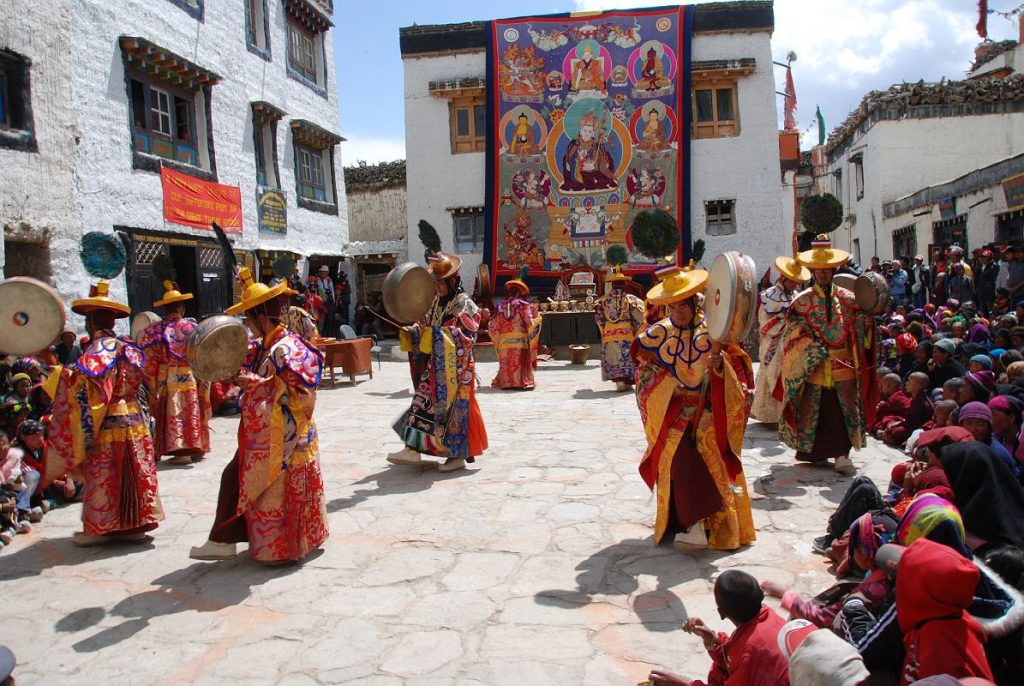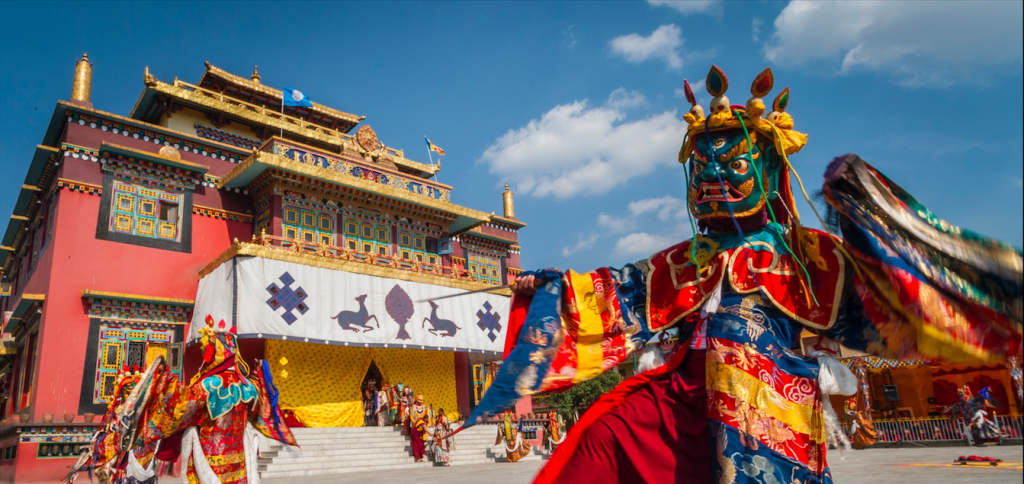The Himalayas are one of the most surreal places on Earth. The first thing that comes to our mind when we talk about the Himalayas. Such as the snow-capped mountains, glacier lakes, and wildlife because for long it has been popularized that way. But beyond the landscapes, the Himalayas of Nepal. Also house unique and exotic culture and festivals, most of which are still alien to many. Hence, digging a little deeper will undoubtedly give a different perspective to the Himalayas. Who knows, you might even want to combine your next visit to Nepal with one of these festivals.
Tiji is a three-day masked dance festival celebrated annually with high significance in the last forbidden kingdom of Lo-Manthang. You would be fascinated to know that Tiji (as we commonly call it) is a slurred version of ‘Tenchi’ which again is just an abbreviation of the term ‘Tempa Chirim.’ People believe that a deity known as Dorjee Shunu was reborn in the kingdom of Lo to destroy the evil and sufferings created by demons on the earth. By performing several powerful dances and taking various forms, he single-handedly defeated the demons to restore peace in the country. Ever since, this masked festival of dances is celebrated to mark the victory of good over evil. These days, the grandeur of this colorful festival attracts hundreds of tourists from different parts of the world.


Tiji is celebrated between the 27th to 29th days of the third Tibetan month (around mid/end of May). Before the main event, at sowo’ (the main dancer of the ceremony who embodies Dorjee Shunu) is selected from the monks of Lo Manthang’s Choede Monastery based on the superiority of rank and precedence. The one who qualifies has to receive Phurba empowerment from a high lama of Shakyapa clan, must be very well acquainted with the verses of the scriptures, has to know the complete rituals and practice the dance steps to lead the ceremony for the three days. The show must undergo a recluse for three months in outright isolation in the monastery to prepare himself for Tiji. The only people who can accompany him are other Lamas who will be performing the masked dance festival disguised as different characters.
Throughout the main event of three days, the religious assembly starts in the Thubchen monastery every morning.
Yartung is perhaps the most famous festival in Mustang and Manang regions, and many trekkers try to coincide with their trek so that they can witness this festival. It is basically 4 days of debauchery and daredevilry. The main attractions of this festival are archery contest, horse riding and not to forget, lots of drinking! Yartung is celebrated just before the harvest is brought and right after the plantation ends. “Yar” means ‘monsoon’ and “Tung” means ‘end.’ So basically it means the end of monsoon. This is the time when the Himali people have more time than ever and decide to make the best use of this boring period.
Yartung festival is also famous for the horse racing festival because of the incredible displays of horsemanship by the young lads. The racing of the horse happens bareback or saddle. One race requires the riders to pick a silk scarf from the ground while running on the horseback at full speed. Another competition tests the riders’ target skills as they have to throw stones at a target whilst on horseback at great speeds. The targets represent the evils and obstacles to a prosperous life they say. Archery competitions are also organized along with merrymaking and drinking excessively. It will definitely be a fun festival to witness. Yartung is celebrated on the full moon day of August every year.
Here are the predicted dates for the next four years (dates may not be 100% accurate. So it is wise to confirm when the festival nears). The given dates are the last days of the 4-day festival: 2019: 15 August, Thursday 2020: 3 August, Monday 2021: 22 August, Sunday. Having said that, different places celebrate Yartung on different dates. The one that is celebrated in the Muktinath region coincides with the Janai Purnima dates.
This great festival is dedicated to the Lord of the Dance who closely resembles Avalokiteshvara, The Buddha of Compassion. While the Tengboche edition of this festival is now the most famous, it has its roots in a similar festival in Rongphu Monastery beyond Everest. Rongphu, in turn, received it from that great center of the Nyingma sect of Tibetan Buddhism- The Mindrolling Monastery in Central Tibet.
The festival lasts for around 19 days of which only the last three are open to the public. The entire festival can be broken down into creative and destructive parts. A word of caution about the word ‘destructive’ is due here. While we carnal beings see creation and destruction as mutually exclusive, diagonally opposite even, under Tibetan Buddhism this duality is seen as complementary.


As such the word ‘destructive’ has no negative connotation as destruction is central to the existence of creation. The creative part is set to coincide with the waxing moon and includes such events as a construction of the symbol of the universe (the colorful Sand Mandala), spiritual medicine (Mani Rilwu) and butter offerings (Torma).
The monks also recite prayers for the well being of the universe during this period. The creative period comes to a climax during the full moon when the gate of the monastery is opened to the public to receive blessings (Wong). The next day is the most anticipated part of the festival. Various dances are performed on this day with each one more amazing than the other. Most of the performances symbolize the destruction of negative forces. There are also numerous comical interludes in between. The day after the masked dances, there is a fire ritual (Jinsak) in which evil is destroyed symbolically. The meticulously created mandala is also destroyed during this day.
The best places to experience Mani Rimdu are Tengboche Monastery (Khumbu, Everest Region), Chiwong Monastery (Solu, Everest Region) and Thame Monastery (Thame, Khumbu).
Dumji is one of the most important festivals of the Sherpas and commemorates the birth of the legendary Guru Padmasambhava. While in the rest of the world the Guru’s birthday is celebrated on the tenth day of the sixth Tibetan month, here in Khumbu it is celebrated a month earlier and festivities begin on the first day of the fifth month. The first 6 days are usually preparative with the villagers going to the designated organizer’s homes to lend them a hand. The festival proper begins on the seventh day when the flagpole is hoisted in the monastery. In the following days, there are masked dances, fire rituals, changing of prayer flags around the village and most importantly the worship of Khumbila, the patron deity of the entire Khumbu region.
This festival is celebrated in the five communities of Phakding, Namche, Khumjung, Thame, and Pangboche, with the Namche and Khumjung editions deserving a special mention. Very few outsiders get to see this festival though as it happens in June-July when the monsoon is in full swing. However, if you want to see this amazing festival in 2019, July 9-12 is the time to go for the most happening four days of the festival.
Mitha (Dhachang) festival is a Manang valley specific festival which is characterized by archery competition. This six days long festival is celebrated to welcome the spring season as the farmers get ready for cultivation season. What do they do then? They bow and arrow! And the young females cheer and throw juniper branches at the males who could hit the target. Imagine the number of girls after a bachelor that gets the most hits! The girls also prepare food and offer drinks to the contestants. The villagers also indulge themselves in singing and dancing. It is very similar to Toranla festival celebrated by the Thakali people in the Kali Gandaki valley. The festival is celebrated in April/May every year.


It is as though the spirit of Michael Jackson enters the bodies of monks in various monasteries. For they perform a masked dance during the Dhekep festival. On certain days during October/ November people gather in the courtyard of their local gompa. And witness the ecstatic masked dance of the monks. It coincides with the Tihar festival of the Hindus.
Shopping is my option in contrast to Red Bull. Regardless…


Hundreds of years of preservation and perseverance, nourished and timely…
Among the many 12 years festivals Nepal has, Lha Phewa…